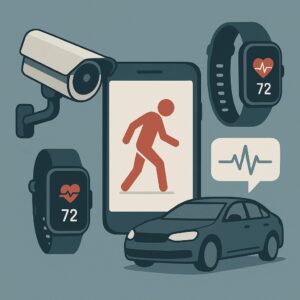Technology has fundamentally changed how personal injury claims are investigated, documented, and argued. From surveillance footage and smartphone data to wearable fitness trackers and vehicle telematics, the digital tools available today can provide critical evidence that either strengthens or complicates a case. Working with experts like TK Injury Lawyers ensures that this technology is used effectively, helping clients demonstrate the severity of their injuries, establish timelines, and counter inaccurate or incomplete insurance claims.
The Role of Video Evidence
Security footage, dashcams, and surveillance cameras are now beneficial in personal injury cases. These recordings can give precise descriptions of incidents, including the order of events, the surrounding circumstances, and even the actions of the participants. To find areas of liability or contradictions in opposing statements, attorneys can examine this video.
Video evidence is powerful, but it can also be incomplete or misconstrued. Poor camera angles, few frames, or low resolution may not fully capture the context of an accident. Expert attorneys carefully assess video evidence, occasionally collaborating with technical specialists to ensure accurate, legally admissible interpretations.
Using Wearables and Fitness Trackers
Heart rate, steps, sleep patterns, movement, and other health and activity data are all recorded by wearable technology, such as fitness trackers and smartwatches. This information can be used in personal injury claims to show how an injury affects a client’s day-to-day activities, such as decreased mobility, disturbed sleep, or restrictions on physical activity.
But there are drawbacks to wearables as well. Data may be incomplete or require verification to ensure it correlates with the claimed injury period. Opposing parties may also contest the veracity or applicability of such information. Experienced personal injury lawyers understand how to appropriately incorporate this evidence to bolster a case while foreseeing possible objections from defense or insurance companies.
Vehicle Telematics and Accident Reconstruction
Sensors and telematics systems that record speed, braking patterns, and other operational data are frequently found in modern cars. This information can help explain the specifics of an accident, especially in complicated collisions or multi-vehicle incidents. Attorneys can use telematics to reconstruct the incident and determine whether carelessness or negligence caused the harm.
Due to the complexity and ambiguity of raw vehicle data, proper analysis requires expertise. To present this evidence clearly and convincingly, attorneys work with engineers or accident reconstruction experts. It can significantly bolster a personal injury claim when appropriately applied.
The Challenges of Digital Evidence
Digital evidence is not always simple, despite its benefits. Data integrity, chain of custody, and privacy issues can all cause problems. For instance, wearable data may be insufficient, and social media posts or smartphone GPS may conflict with a client’s account. Digital evidence must be handled carefully, documented, and, if required, supported by expert testimony to be admitted in court.
The pace of technological development is another factor. Relevant evidence may be stored differently or be more difficult to access in the future. Attorneys must stay up to date with technological trends and legal standards to fully leverage these tools for clients’ benefit.
Best Practices for Clients
Individuals involved in personal injury claims can take several proactive steps to maximize the effectiveness of technology in their case:
- Preserve all digital evidence immediately, including video, email, text messages, and device data.
- Maintain wearable device logs and ensure they are synchronized correctly.
- Avoid deleting messages or social media posts that relate to the incident.
- Consult an attorney early to develop a strategy for collecting and presenting evidence effectively.
These steps help ensure that technology supports, rather than complicates, a claim. A knowledgeable personal injury attorney can guide clients in using technology safely and strategically.
Final Thoughts
Technology has transformed the landscape of personal injury claims, offering both opportunities and challenges. From video footage and telematics to wearable devices and social media records, digital evidence can clarify events, demonstrate injury impacts, and support fair compensation. Partnering with TK Injury Lawyers allows clients to use these tools strategically, ensuring that evidence is presented accurately, effectively, and in a way that strengthens their case. Proper guidance turns technology into an asset that safeguards both legal rights and long-term recovery.






